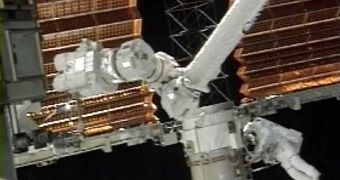Yesterday, two of the astronauts on board the International Space Station floated outside to work on the retraction of the starboard solar array. They helped fold up an old solar wing and to resurrect a rotating joint that will make the new pair of solar arrays follow the Sun.
Last week, two Russian cosmonauts on board the International Space Station (ISS) walked out into space and climbed on the station to install deflector shields, in fact protective panels designed to shield the orbiting station from dangerous space debris and small meteorites.
Patrick Forrester and Steve Swanson are the two astronauts that performed a seven-hour-plus spacewalk, during which they retracted the 350-meter (115-foot) solar wing in its box, using specially designed space tools.
"We're going to call it quits on this part of your job for today. Excellent job," astronaut James Reilly told the spacewalkers. It may sound like an easy job, but the last folding procedure, in December, was actually complicated by guide wires that got stuck on grommets.
Folding the old solar panels is part of a bigger operation to replace them with new ones that were delivered to the space station this week, which can follow the sun to generate electrical power for the orbiting station, with the help of a rotating joint the size of a car.
According to NASA, the ISS is an extremely important part of the Vision for Space Exploration. "NASA is moving forward with a new focus for the manned space program: to go out beyond Earth orbit for purposes of human exploration and scientific discovery. And the International Space Station is now a stepping stone on the way, rather than being the end of the line," said NASA Administrator Mike Griffin.
Since 1961, more than 400 human beings have ventured into space, most of them during maintenance missions for space shuttles and space stations like the ISS and the late Russian MIR station.

 14 DAY TRIAL //
14 DAY TRIAL //